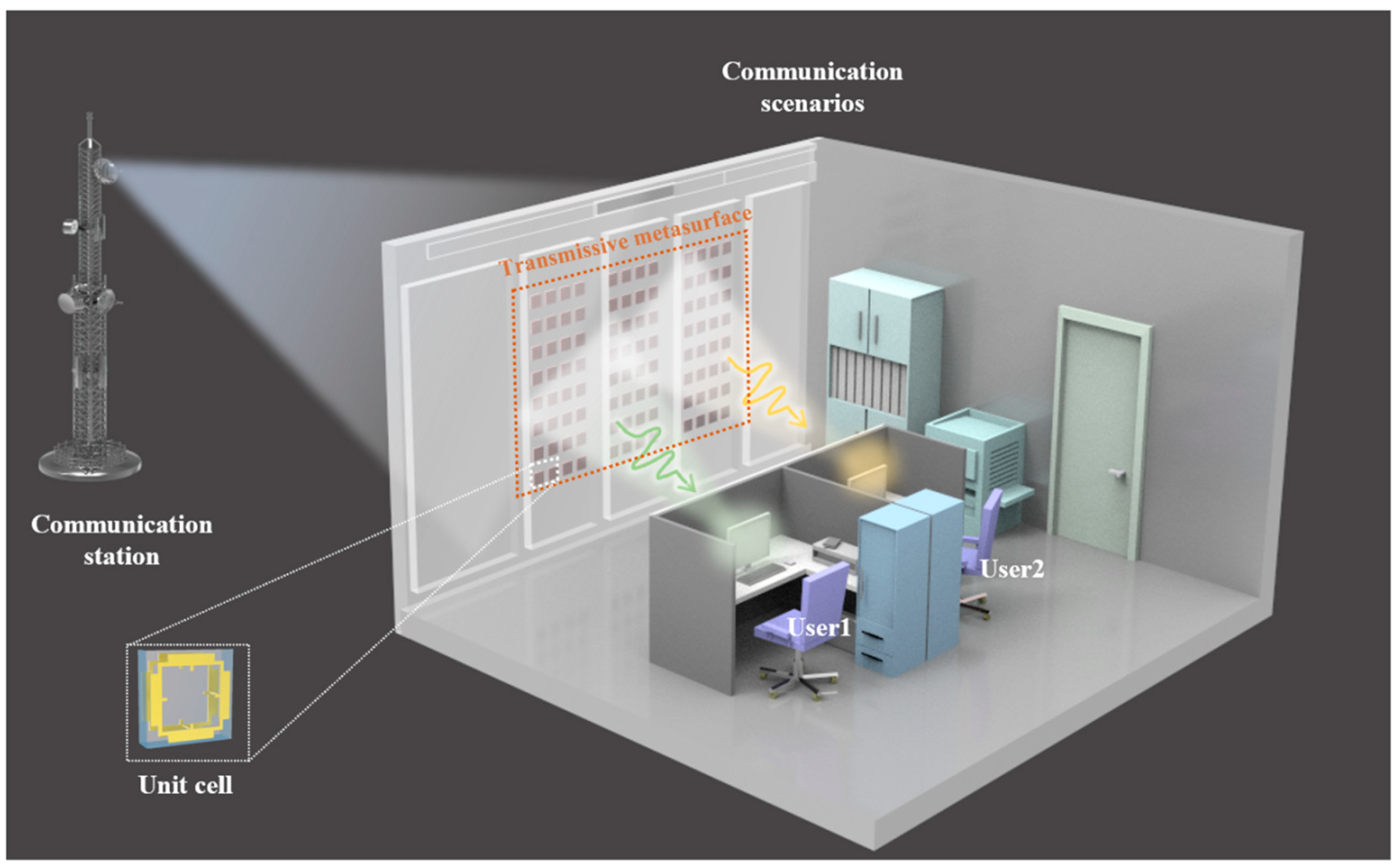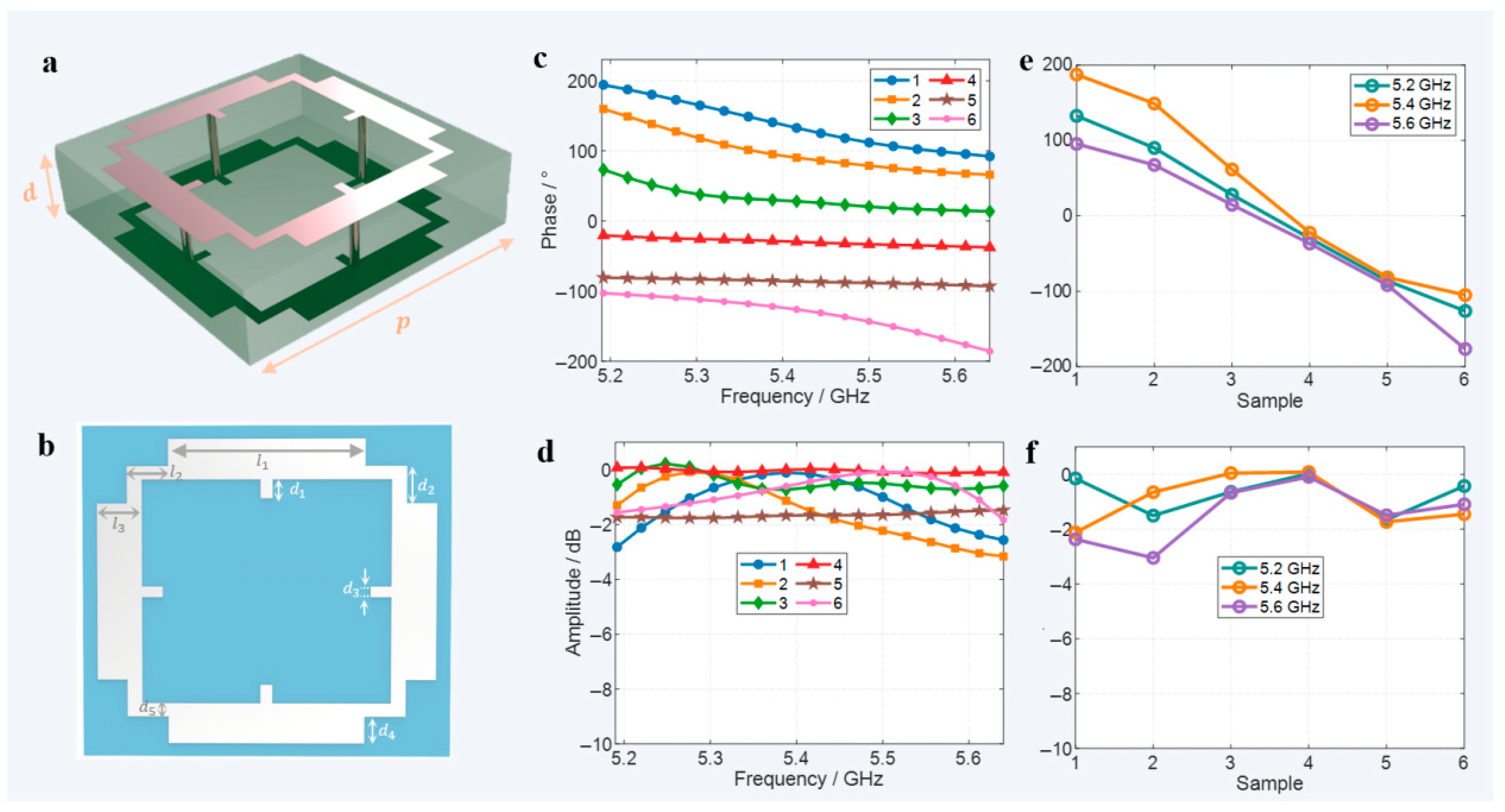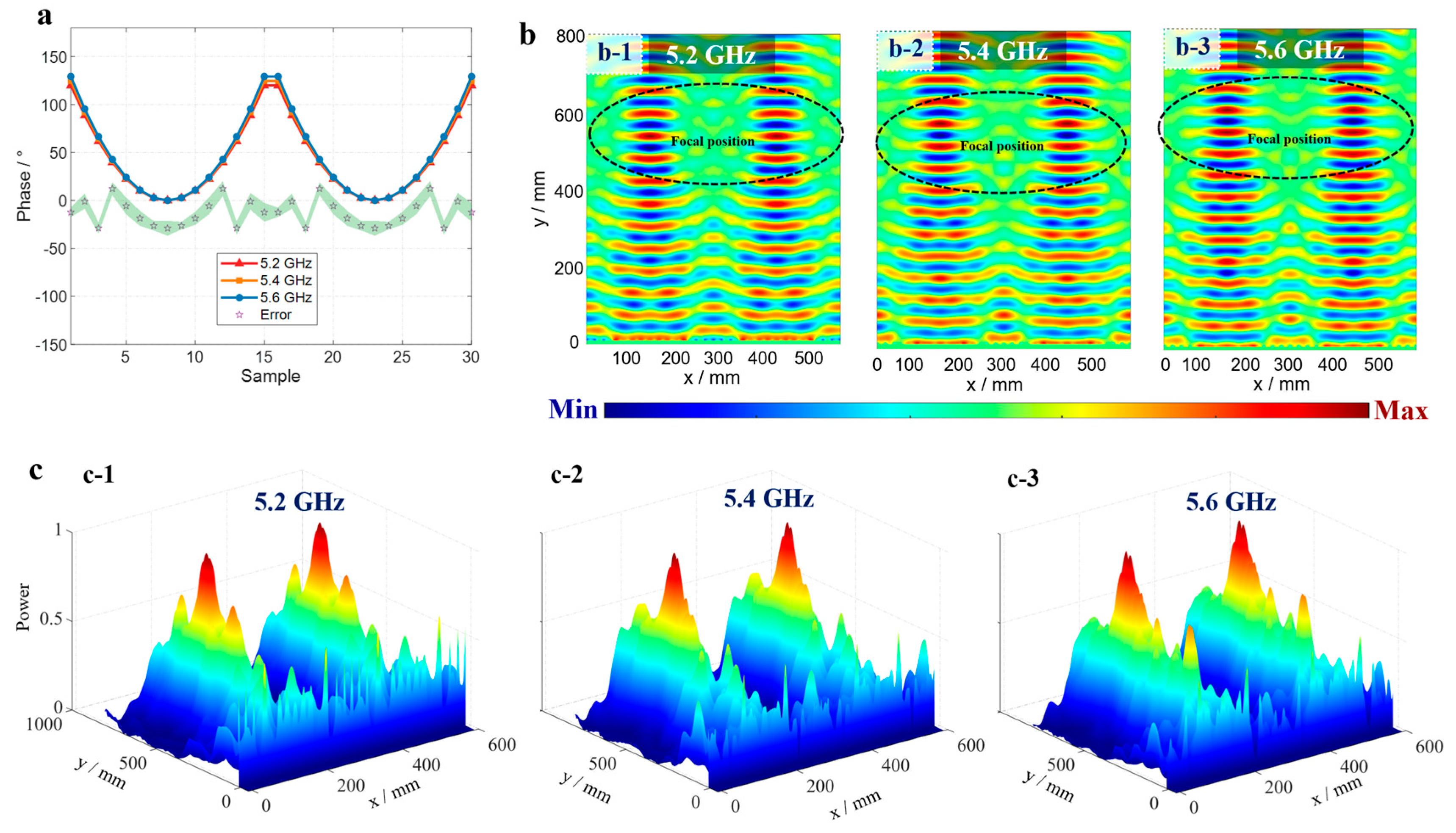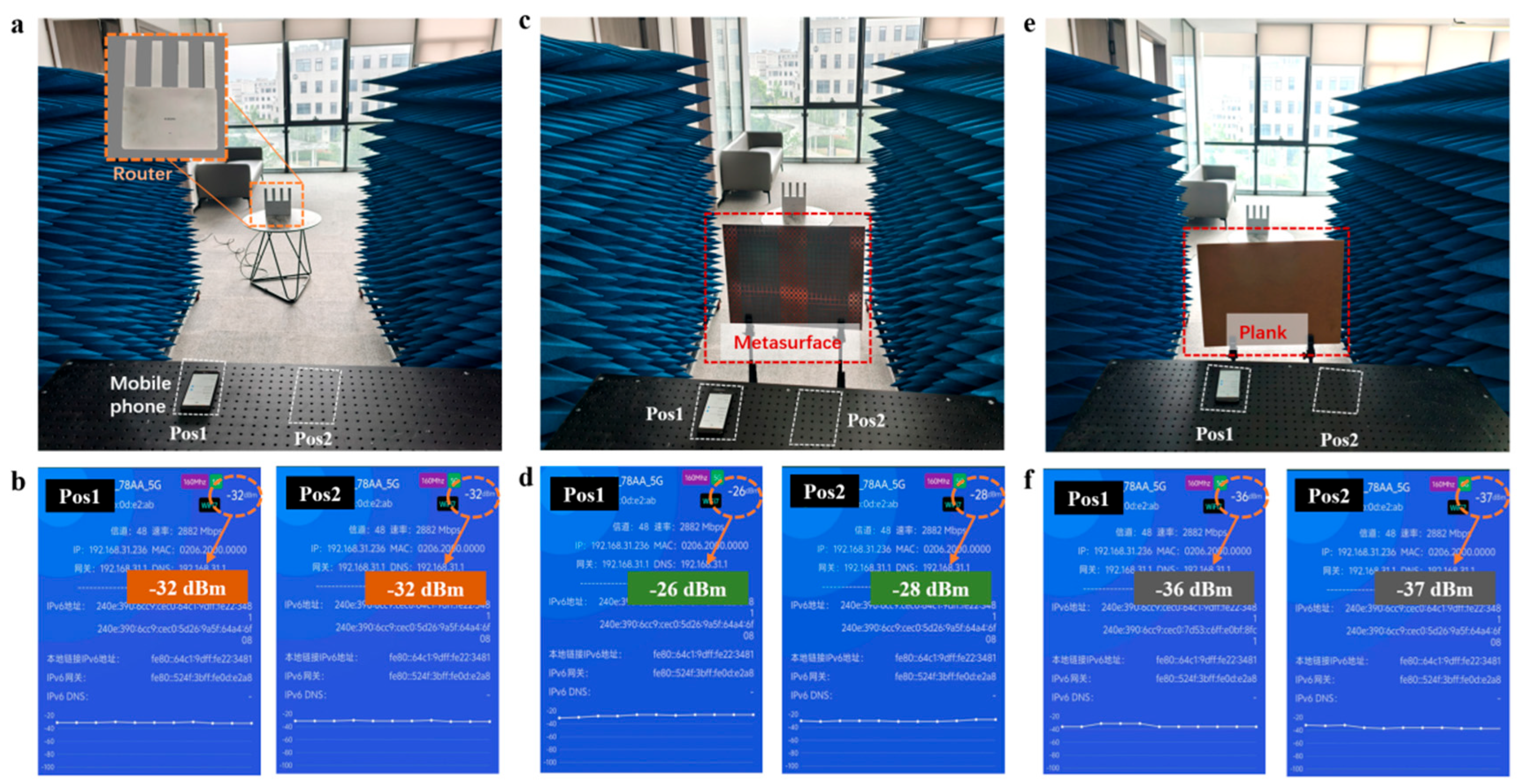Single-Layer High-Efficiency Metasurface for Multi-User Signal Enhancement
Abstract
1. Introduction
2. Results
3. Conclusions
Supplementary Materials
Author Contributions
Funding
Data Availability Statement
Conflicts of Interest
References
- Marzetta, T.L. Noncooperative cellular wireless with unlimited numbers of base station antennas. IEEE Trans. Wireless Commun. 2010, 9, 3590–3600. [Google Scholar] [CrossRef]
- Zhao, J.; Yu, Q.; Qian, B.; Yu, K.; Xu, Y.; Zhou, H.; Shen, X. Fully-decoupled radio access networks: A resilient uplink base stations cooperative reception framework. IEEE Trans. Wireless Commun. 2023, 22, 5096–5110. [Google Scholar] [CrossRef]
- Chen, H.; Wu, B.; Zhang, B.; Kong, J. Electromagnetic wave interactions with a metamaterial cloak. Phys. Rev. Lett. 2007, 99, 063903. [Google Scholar] [CrossRef] [PubMed]
- Basar, E.; Di Renzo, M.; de Rosny, J.; Debbah, M.; Alouini, M.-S.; Zhang, R. Wireless communications through reconfigurable intelligent surfaces. IEEE Access 2019, 7, 116753–116773. [Google Scholar] [CrossRef]
- Shafi, M.; Molisch, A.F.; Smith, P.J.; Haustein, T.; Zhu, P.; De Silva, P.; Tufvesson, F.; Benjebbour, A.; Wunder, G. 5G: A tutorial overview of standards, trials, challenges, deployment, and practice. IEEE J. Sel. Areas Commun. 2017, 35, 1201–1221. [Google Scholar] [CrossRef]
- Ivanov, V.; Volkov, A.; Peters, D.R. Geometrical modeling and experimental measurements of indoor mm-wave systems including finite-area reflective surfaces. Prog. Electromagn. Res. 2025, 182, 107–119. [Google Scholar] [CrossRef]
- Yuan, J.; Franek, O.; Fang, H.; Popovski, P. Indoor RIS-assisted wireless system with location-based reflective patterns. IEEE Trans. Commun. 2024, 72, 6722–6736. [Google Scholar] [CrossRef]
- Pan, T.; Liu, C.; Peng, S.; Lu, H.; Zhang, H.; Xu, X.; Yang, F. A terahertz programmable digital metasurface based on vanadium dioxide. Photonics 2024, 11, 527. [Google Scholar] [CrossRef]
- Chen, H.; Zheng, B.; Shen, L.; Wang, H.; Zhang, X.; Zheludev, N.I.; Zhang, B. Ray-optics cloaking devices for large objects in incoherent natural light. Nat. Commun. 2013, 4, 2652. [Google Scholar] [CrossRef]
- Jing, X.; Wu, Y.; Yu, F.; Xu, Y.; Wang, X. Reconfigurable intelligent surface-aided security enhancement for vehicle-to-vehicle visible light communications. Photonics 2024, 11, 1151. [Google Scholar] [CrossRef]
- Rangan, S.; Rappaport, T.S.; Erkip, E. Millimeter-wave cellular wireless networks: Potentials and challenges. Proc. IEEE 2014, 102, 366–385. [Google Scholar] [CrossRef]
- Huang, C.; Zappone, A.; Alexandropoulos, G.C.; Debbah, M.; Yuen, C. Reconfigurable intelligent surfaces for energy efficiency in wireless communication. IEEE Trans. Wireless Commun. 2019, 18, 4157–4170. [Google Scholar] [CrossRef]
- Uyoata, U.E.; Mwangama, J.; Adeogun, R.O. Relaying in the Internet of Things (IoT): A survey. IEEE Access 2021, 9, 132675–132704. [Google Scholar] [CrossRef]
- Yang, Y.; Jing, L.; Zheng, B.; Hao, R.; Yin, W.; Li, E.; Soukoulis, C.M.; Chen, H. Full-polarization 3D metasurface cloak with preserved amplitude and phase. Adv. Mater. 2016, 28, 6866–6871. [Google Scholar] [CrossRef]
- Chen, H.; Ran, L.; Huangfu, J.; Zhang, X.; Chen, K.; Grzegorczyk, T.M.; Kong, J.A. Left-handed material composed of only S-shaped resonators. Phys. Rev. E 2004, 70, 057605. [Google Scholar] [CrossRef] [PubMed]
- Cai, T.; Zhong, Y.; Liu, D.; Huang, H.; Wang, D.; Yang, Y.; Chen, H.; Lin, X. Observation of polarization-maintaining near-field directionality. Prog. Electromagn. Res. 2024, 181, 35–41. [Google Scholar] [CrossRef]
- Xi, S.; Chen, H.; Jiang, T.; Ran, L.; Huangfu, J.; Wu, B.-I.; Kong, J.A.; Chen, M. Experimental verification of reversed Cherenkov radiation in left-handed metamaterial. Phys. Rev. Lett. 2009, 103, 194801. [Google Scholar] [CrossRef]
- He, Z.; Wang, H.; Cui, Z.; Xia, S.; Tang, X.; Zheng, B.; Lin, X.; Shen, L.; Chen, H.; Wu, Y. Reflectionless Refraction via One-Dimensional Ghost Polaritons in Planar Junctions of Hyperbolic Metasurfaces. Prog. Electromagn. Res. 2024, 181, 1–8. [Google Scholar] [CrossRef]
- Lu, H.; Zhao, J.; Zhu, P.; Song, W.; Zhu, S.; Zhu, R.; Zheng, B.; Chen, H. Neural Network-Assisted Metasurface Design for Broadband Remote Invisibility. Adv. Funct. Mate. 2025, 2506085. [Google Scholar] [CrossRef]
- Qian, C.; Zheng, B.; Shen, Y.; Jing, L.; Li, E.; Shen, L.; Chen, H. Deep-learning-enabled self-adaptive microwave cloak without human intervention. Nat. Photonics 2020, 14, 383–390. [Google Scholar] [CrossRef]
- Lu, H.; Zhao, J.; Zheng, B.; Qian, C.; Cai, T.; Li, E.; Chen, H. Eye accommodation-inspired neuro-metasurface focusing. Nat. Commun. 2023, 14, 3301. [Google Scholar] [CrossRef] [PubMed]
- Qian, C.; Lin, X.; Lin, X.B.; Xu, J.; Sun, Y.; Li, E.; Zhang, B.; Chen, H. Performing optical logic operations by a diffractive neural network. Light Sci. Appl. 2020, 9, 59. [Google Scholar] [CrossRef]
- Qian, C.; Lin, X.; Yang, Y.; Xiong, X.; Wang, H.; Li, E.; Kaminer, I.; Zhang, B.; Chen, H. Experimental observation of superscattering. Phys. Rev. Lett. 2019, 122, 063901. [Google Scholar] [CrossRef]
- Zhang, L.; Yang, Y.; Ge, Y.; Guan, Y.-J.; Chen, Q.; Yan, Q.; Chen, F.; Xi, R.; Li, Y.; Jia, D.; et al. Acoustic non-Hermitian skin effect from twisted winding topology. Nat. Commun. 2021, 12, 6207. [Google Scholar] [CrossRef]
- Wang, Q.; Paulus, A.H.; Tong, M.S.; Eibert, T.F. An Indoor Localization Technique Utilizing Passive Tags and 3-D Microwave Passive Radar Imaging. Prog. Electromagn. Res. 2024, 181. [Google Scholar] [CrossRef]
- Qian, C.; Jia, Y.; Wang, Z.; Chen, J.; Lin, P.; Zhu, X.; Li, E.; Chen, H. Autonomous aero-amphibious invisibility cloak with stochastic-evolution learning. Adv. Photonics 2024, 6, 016001. [Google Scholar] [CrossRef]
- Wang, D.; Cui, X.; Liu, D.; Zou, X.; Wang, G.-M.; Zheng, B.; Cai, T. Multi-characteristic integrated ultra-wideband frequency selective rasorber. Prog. Electromagn. Res. 2024, 179, 49–59. [Google Scholar] [CrossRef]
- Zhu, R.; Liu, D.; Lu, H.; Peng, L.; Cai, T.; Zheng, B. High-efficiency Pancharatnam–Berry metasurface-based surface-plasma coupler. Adv. Photonics Res. 2023, 4, 2300315. [Google Scholar] [CrossRef]
- Zhou, Y.; Liu, Y.; Liang, H.; Li, J. Efficient inverse design of large-scale, ultrahigh-numerical-aperture metalens. Photonics 2024, 11, 940. [Google Scholar] [CrossRef]
- He, X.; Qi, C.; Lei, S.; Wong, A.M.H. Polarization-independent achromatic Huygens’ metalens with large numerical aperture and broad bandwidth. Nanophotonics 2023, 12, 3633–3644. [Google Scholar] [CrossRef] [PubMed]
- Lu, H.; Luo, C.; Pei, Z.; Zhu, P.; Dong, Y.; Chen, C.; Zhu, R.; Zhao, J. FlexSARCloak: A flexible SAR cloak driven by task-oriented learning. ACS Appl. Mater. Interfaces 2025, 17, 2139–2147. [Google Scholar] [CrossRef]
- Wang, S.; Wu, P.C.; Su, V.-C.; Lai, Y.-C.; Chu, C.H.; Chen, J.-W.; Lu, S.-H.; Xu, B.; Kuan, C.-H.; Li, T.; et al. Broadband achromatic optical metasurface devices. Nat. Commun. 2017, 8, 187. [Google Scholar] [CrossRef]
- Alkhateeb, A.; Leus, G.; Heath, R.W. Limited feedback hybrid precoding for multi-user millimeter-wave systems. IEEE Trans. Wireless Commun. 2015, 14, 6481–6494. [Google Scholar] [CrossRef]
- Park, S.; Alkhateeb, A.; Heath, R.W. Dynamic subarrays for hybrid precoding in wideband mm-wave MIMO systems. IEEE Trans. Wireless Commun. 2017, 16, 2907–2920. [Google Scholar] [CrossRef]
- Lin, P.; Qian, C.; Zhang, J.; Chen, J.; Zhu, X.; Wang, Z.; Huangfu, J.; Chen, H. Enabling intelligent metasurfaces for semi-known input. Prog. Electromagn. Res. 2023, 178, 83–91. [Google Scholar] [CrossRef]
- Zheng, B.; Lu, H.; Qian, C.; Ye, D.; Luo, Y.; Chen, H. Revealing the transformation invariance of full-parameter omnidirectional invisibility cloaks. Electromagn. Sci. 2023, 1, 0020092. [Google Scholar] [CrossRef]
- Yang, Y.; Gao, Z.; Xue, H.; Zhang, L.; He, M.; Yang, Z.; Singh, R.; Chong, Y.; Zhang, B.; Chen, H. Realization of a three-dimensional photonic topological insulator. Nature 2019, 565, 622–626. [Google Scholar] [CrossRef] [PubMed]
- Xue, H.; Ge, J.; Zhang, Y.; Jiang, X.; Zhang, C.; Dong, H.; Zhang, L. An optically transparent metasurface for microwave amplitude–phase manipulation. Photonics 2025, 12, 384. [Google Scholar] [CrossRef]
- Zhao, H.; Shuang, Y.; Wei, M.; Cui, T.J.; del Hougne, P.; Li, L. Metasurface-assisted massive backscatter wireless communication with commodity Wi-Fi signals. Nat. Commun. 2020, 11, 3926. [Google Scholar] [CrossRef]
- Bai, X.; Tan, S.; Mikki, S.M.; Li, E.P.; Cui, T.J. Information-theoretic measures for reconfigurable metasurface-enabled direct digital modulation systems: An electromagnetic perspective. Prog. Electromagn. Res. 2024, 179, 1–18. [Google Scholar] [CrossRef]
- Li, L.; Cui, T.J.; Ji, W.; Liu, S.; Ding, J.; Wan, X.; Li, Y.B.; Jiang, M.; Qiu, C.-W.; Zhang, S. Electromagnetic reprogrammable coding-metasurface holograms. Nat. Commun. 2017, 8, 197. [Google Scholar] [CrossRef] [PubMed]
- Wang, J.; Li, Y.; Jiang, Z.H.; Shi, T.; Tang, M.-C.; Zhou, Z.; Chen, Z.N.; Qiu, C.-W. Metantenna: When metasurface meets antenna again. IEEE Trans. Antennas Propag. 2020, 68, 1332–1347. [Google Scholar] [CrossRef]
- Meng, Z.; Xiao, Y.; Chen, L.; Wang, S.; Fang, Y.; Zhou, J.; Li, Y.; Zhang, D.; Pu, M.; Luo, X. Floating multi-focus metalens for high-efficiency airborne laser wireless charging. Photonics 2025, 12, 150. [Google Scholar] [CrossRef]
- Wu, Q.; Zhang, R. Towards smart and reconfigurable environment: Intelligent reflecting surface aided wireless network. IEEE Commun. Mag. 2019, 58, 106–112. [Google Scholar] [CrossRef]
- Tian, H.W.; Sun, Y.L.; Zhang, X.G.; Li, X.; Zhu, Q.; Song, C.; Qiu, C.-W.; Cui, T.J.; Jiang, W.X. Solar-powered light-modulated microwave programmable metasurface for sustainable wireless communications. Nat. Commun. 2025, 16, 2524. [Google Scholar] [CrossRef]
- Fathnan, A.A.; Liu, M.; Powell, D.A. Achromatic Huygens’ metalenses with deeply subwavelength thickness. Adv. Opt. Mat. 2020, 8, 22. [Google Scholar] [CrossRef]
- Yang, J.; Wang, J.; Li, Y.; Pang, Y.; Meng, Y.; Cheng, Q.; Cui, T.J.; Qu, S. 2D achromatic flat focusing lens based on dispersion engineering of spoof surface plasmon polaritons: Broadband and profile-robust. J. Phys. D Appl. Phys. 2018, 51, 4. [Google Scholar] [CrossRef]
- Yang, J.; Wang, J.; Feng, M.; Li, Y.; Wang, X.; Zhou, X.; Cui, T.; Qu, S. Achromatic flat focusing lens based on dispersion engineering of spoof surface plasmon polaritons. Appl. Phys. Lett. 2017, 110, 20. [Google Scholar] [CrossRef]
- Ji, W.; Cai, T.; Xi, Z.; Urbach, P. Highly efficient and broadband achromatic transmission metasurface to refract and focus in microwave region. Laser Photonics Rev. 2022, 16, 2100333. [Google Scholar] [CrossRef]





Disclaimer/Publisher’s Note: The statements, opinions and data contained in all publications are solely those of the individual author(s) and contributor(s) and not of MDPI and/or the editor(s). MDPI and/or the editor(s) disclaim responsibility for any injury to people or property resulting from any ideas, methods, instructions or products referred to in the content. |
© 2025 by the authors. Licensee MDPI, Basel, Switzerland. This article is an open access article distributed under the terms and conditions of the Creative Commons Attribution (CC BY) license (https://creativecommons.org/licenses/by/4.0/).
Share and Cite
Jin, H.; Zhu, P.; Zhu, R.; Yang, B.; Zhang, S.; Lu, H. Single-Layer High-Efficiency Metasurface for Multi-User Signal Enhancement. Micromachines 2025, 16, 911. https://doi.org/10.3390/mi16080911
Jin H, Zhu P, Zhu R, Yang B, Zhang S, Lu H. Single-Layer High-Efficiency Metasurface for Multi-User Signal Enhancement. Micromachines. 2025; 16(8):911. https://doi.org/10.3390/mi16080911
Chicago/Turabian StyleJin, Hui, Peixuan Zhu, Rongrong Zhu, Bo Yang, Siqi Zhang, and Huan Lu. 2025. "Single-Layer High-Efficiency Metasurface for Multi-User Signal Enhancement" Micromachines 16, no. 8: 911. https://doi.org/10.3390/mi16080911
APA StyleJin, H., Zhu, P., Zhu, R., Yang, B., Zhang, S., & Lu, H. (2025). Single-Layer High-Efficiency Metasurface for Multi-User Signal Enhancement. Micromachines, 16(8), 911. https://doi.org/10.3390/mi16080911






